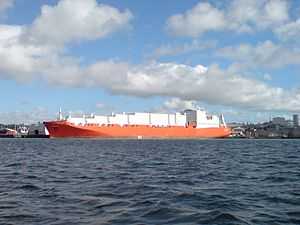MV Taiko
 Taiko in the Port of Auckland, New Zealand | |
| Career | |
|---|---|
| Name: |
1984-1988: Barber Hector from 1988: Taiko |
| Owner: | Wilhelmsen Lines |
| Operator: | Wallenius Wilhelmsen Logistics |
| Port of registry: |
|
| Builder: |
Hyundai Heavy Industries Ulsan, South Korea |
| Yard number: | 250, |
| Completed: | 1984 |
| Identification: | IMO number: 8204975 |
| Notes: | [1][2] |
| General characteristics | |
| Tonnage: | 39,900 DWT 66,532 GT |
| Length: | 262.3 m (861 ft) |
| Beam: | 32.26 m (105.8 ft) |
| Draught: | 9.78 m (32.1 ft) |
| Decks: | 2 hoistable decks, further RoRo vehicle decks |
| Speed: | 21 knots (39 km/h; 24 mph) |
| Crew: | 25 |
| Notes: | [3] |
MV Taiko is a roll-on/roll-off (RoRo) freighter managed by the Norwegian-Swedish shipping line Wallenius Wilhelmsen Logistics. She was built as Barber Hector by Hyundai Heavy Industries at Ulsan, South Korea in 1984 for Blue Funnel Line, part of the Liverpool company Ocean Transport & Trading Ltd, and was Blue Funnel's last newbuilding.[4] She was deployed on Barber Blue Sea Line, a joint venture between Blue Funnel, Wilh. Wilhelmsen, Oslo and the Broström Group of Sweden.[4][5] In 1988 Ocean withdrew from Barber Blue Sea line and Barber Hector was sold to the Swedish partner, chartered to Wilhelmsen and renamed Taiko.[4][6] Wilhelmsen purchased the vessel in 1993.[6]
Built to carry RoRo cargoes and containers, the ship initially had a tonnage of 27,990 GT.[4][6] In 2008 Taiko was converted to a vehicle carrier in China, resulting in an increase to 66,532 GT.[2][6] In addition to its car decks, loaded and unloaded through a ramp with 400 tonnes carrying capacity (via a 6.4 m high and 12.5 m wide hatch), it has two hoistable decks.[1]
In December 2013, Taiko was hired by the Norwegian Government to transport Syrian chemical weapons abroad for destruction, involving also the Danish cargo ship Ark Futura, under protection of the Norwegian Fridtjof Nansen-class frigate HNoMS Helge Ingstad and the Danish Absalon-class support ship HDMS Esbern Snare as well as Chinese, Russian and British warships.[7][8][9] Specialist military personnel were also placed on board.[10] Taiko loaded chemicals at the Syrian port of Latakia, for transport to Finland and the USA for destruction.[10][11]
See also
- MV Tampa (sister ship)
References
- ↑ 1.0 1.1 Fleet List (from the Wallenius Wilhelmsen Logistics website. Accessed 2008-03-11.)
- ↑ 2.0 2.1 Taiko (from the 'shippingdatabase.com' website. Accessed 2008-03-11.)
- ↑ "MV Taiko". Wilh. Wilhelmsen. 2010. Retrieved 4 June 2010.
- ↑ 4.0 4.1 4.2 4.3 Clarkson, John; Harvey, Bill; Fenton, Roy (1998). Blue Funnel Line. Preston: Ships in Focus. p. 178. ISBN 1-901703-01-0.
- ↑ "Second of three RoRo ships ordered by BBSL". Maritime Reporter. May 1984. Retrieved 26 June 2014.
- ↑ 6.0 6.1 6.2 6.3 "M/S Barber Hector". Faktaomfartyg. Retrieved 26 June 2014.
- ↑ "How the Chemical components of the Syrian chemical warfare stockpile will be destroyed". Organisation for the Prohibition of Chemical Weapons. Retrieved 25 June 2014.
- ↑ "First load of chemical weapons has left Syria". Oslo: Ministry of Foreign Affairs. 7 January 2014. Retrieved 25 June 2014.
- ↑ "HMS Montrose thanked for her contribution to remove chemical weapons from Syria". London: Royal Navy. 17 February 2014. Retrieved 25 June 2014.
- ↑ 10.0 10.1 "Historic mission in Syria nears conclusion". Ministry of Foreign Affairs, Oslo. 23 June 2014. Retrieved 25 June 2014.
- ↑ "Cape Ray faces Syrian chemical weapons delay". IHS Maritime 360. 13 April 2014. Retrieved 25 June 2014.